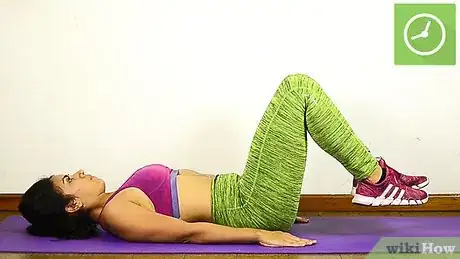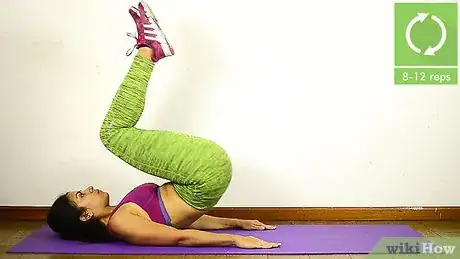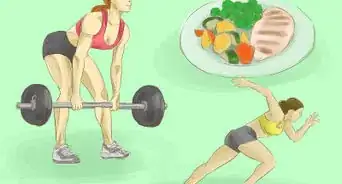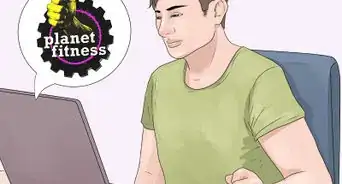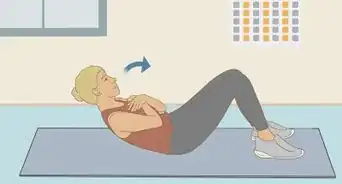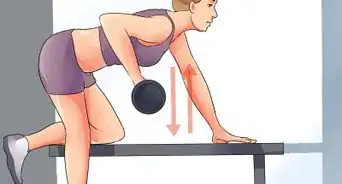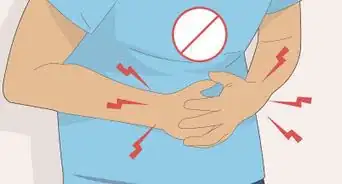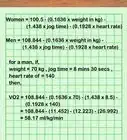This article was co-authored by Tiffany Stafford, CPT. Tiffany Stafford is a Certified Personal Trainer, Holistic Nutritionist, and the Owner of LifeBODY Fitness, a personal training and small group training studio based in Hillsboro, Oregon. She has over 15 years of personal training and coaching experience. She specializes in wellness training, life coaching, and holistic nutrition teaching. She earned her personal training certification from the National Academy of Sports Medicine (NASM).
wikiHow marks an article as reader-approved once it receives enough positive feedback. In this case, several readers have written to tell us that this article was helpful to them, earning it our reader-approved status.
This article has been viewed 528,170 times.
The reverse crunch is a core exercise that targets the muscles of the lower abdomen. To perform a reverse crunch, lie flat on your back with your hands beneath your hips. Bend your knees and lift them towards your head, drawing them upward slightly at the end of the movement. Lower your feet back down just above the floor to complete one repetition. Add reverse crunches to your regular core routine to progress along your journey towards a tight, toned waistline!
Steps
Getting into Position
-
1Lie flat on your back. Fully extend your legs, with your toes pointing upward and keeping your gaze focused on the ceiling or sky. Your body should form a straight line from head to toe.[1]
- Relax your shoulders and neck to minimize the tension in your upper body.
- Stretching out on a lightly cushioned surface like a yoga mat or a carpeted section of the floor can make performing the exercise more comfortable.
-
Video Player is loading.
This is a modal window.
The media could not be loaded, either because the server or network failed or because the format is not supported.2Place your arms down beside your body. Reach your fingertips toward your feet on either side of your thighs. Press your palms firmly into the floor to create stability. If you don’t feel quite stable enough in this position, try sliding the backs of your hands beneath your buttocks to anchor your arms closer to your body.[2]Advertisement -
Video Player is loading.
This is a modal window.
The media could not be loaded, either because the server or network failed or because the format is not supported.3Bend your knees if you need to do so. The straighter your legs, the more of an ab workout this exercise gives you. If you're just starting out, though, or if you have limited mobility, you may find it helpful to bend your knees in the beginning. Lift your feet and pull your knees back until your thighs are perpendicular to the floor. Then, tighten the muscles in your hips and thighs to lock your legs in place. They should remain at this angle throughout the entire movement.[3]- With your feet elevated and your knees bent, the tops of your shins should be roughly parallel to the floor.
Performing the Crunch
-
Video Player is loading.
This is a modal window.
The media could not be loaded, either because the server or network failed or because the format is not supported.1Draw your knees toward your head. Contract the muscles of your lower abdomen and bring your bent knees straight back until they’re just in front of your face. Make sure your hips and butt are firmly rooted to the floor. They’ll act as a hinge for your thighs to swivel over.[4]- Don’t forget to breathe. You’ll exhale sharply as you bring your knees up and exhale as you lower them down.
-
Video Player is loading.
This is a modal window.
The media could not be loaded, either because the server or network failed or because the format is not supported.2Lift your knees upward at the top of the movement. As your knees come level with your gaze, push them up in the direction of the ceiling. This should cause your lower back and buttocks to come off the ground by an inch or two.[5]- This extra lift increases the overall range of motion, making the crunch more effective.
- Avoid rocking into the movement or extending your back too forcefully. You’re just looking for a tight vertical tilt to briefly engage your middle and upper abs.
-
Video Player is loading.
This is a modal window.
The media could not be loaded, either because the server or network failed or because the format is not supported.3Lower your knees back to hip level. Let your lower body come down in a slow, controlled manner, stopping when your thighs are once again perpendicular. Reverse the motion of your legs and raise your knees again to start the next repetition. You’ve just completed your first reverse crunch![6] -
4Pause briefly before beginning your next rep. When you return to the starting position, take a split second to steady yourself and neutralize any momentum you’ve built up. That way, you won't be tempted to cheat when transitioning into the next crunch. Your core muscles alone should initiate the movement.[7]
- Pausing momentarily will also give you a chance to catch your breath and assess your technique.
-
Video Player is loading.
This is a modal window.
The media could not be loaded, either because the server or network failed or because the format is not supported.5Aim for 8-12 crunches per set. A low-moderate rep scheme will offer just enough of a challenge when you're first starting out. For best results, make an effort to perform each crunch with proper form and a full range of motion. Your abs will thank you for it![8]- Feel free to pick a higher or lower number to suit your individual fitness level.
- It's okay if you don't get the same number of reps every set. You might be able to complete 12 crunches while you're fresh, but only grind out 8 by the time you reach your final set.
Intensifying the Movement
-
1Increase your total number of repetitions. Once you get to the point where you can do 8-12 reps with ease, gradually work your way up to 15 reps. Keep working until you get up to 3 sets of 15 reps. If you're looking for further intensity after that, try a variation of the exercise such as leg lifts.[9]
- The number of sets you do will depend on your individual goals and the way the rest of your workout is structured. Remember, though, that too many reps of any type of spine crunch can be dangerous long-term.
- Quality is more important than quantity. You’ll only be doing yourself a disservice by letting your technique break down in order to get more reps in.
EXPERT TIPTiffany Stafford is a Certified Personal Trainer, Holistic Nutritionist, and the Owner of LifeBODY Fitness, a personal training and small group training studio based in Hillsboro, Oregon. She has over 15 years of personal training and coaching experience. She specializes in wellness training, life coaching, and holistic nutrition teaching. She earned her personal training certification from the National Academy of Sports Medicine (NASM).Life Coach, Personal Trainer, & Holistic Nutritionist
 Tiffany Stafford, CPT
Tiffany Stafford, CPT
Life Coach, Personal Trainer, & Holistic NutritionistExpert Trick: In addition to increasing repetitions, you can also add in weights to make the crunches more intense and effective. To do this, hold a medicine ball, dumbbell, or another heavy object between your feet as you do the crunch.
-
Video Player is loading.
This is a modal window.
The media could not be loaded, either because the server or network failed or because the format is not supported.2Incorporate a standard crunch. Place your hands above your head or rest your fingertips on your earlobes. Then squeeze your upper abs until your head and shoulders are off the floor. You can either maintain this position as a static hold while doing your reverse crunches, or raise both your upper and lower body simultaneously for a blistering total ab workout.[10]- Make sure your core stays tightly contracted throughout the entire movement to steady yourself and keep both halves of your body moving in sync with one another.
-
Video Player is loading.
This is a modal window.
The media could not be loaded, either because the server or network failed or because the format is not supported.3Try them on a decline bench or chair. Lie on a decline or sit-up bench, or a sturdy household chair, so that your head is higher than your legs and grip the upper end with both hands for support. Then, pull your knees up and back just like you would for a regular reverse crunch. The slight change in angle will introduce a whole new element to the exercise.[11]- A decline bench with variable height settings will allow you to make the movement slightly easier if you're fatigued or struggling to make it through a full range of motion. However, a sturdy chair will work just as well if you don't want to invest in new equipment.
- Performing reverse crunches on a decline forces you to engage the muscles of your lower abs even more.
Community Q&A
-
QuestionIs it bad, when I am doing reverse crunches, for my stomach to hurt? What's the cause of it?
 Community AnswerIt's not really your stomach that's hurting, it's your abdominal muscles. They're letting you know that they're working. It's normal for all abdomen exercises.
Community AnswerIt's not really your stomach that's hurting, it's your abdominal muscles. They're letting you know that they're working. It's normal for all abdomen exercises. -
QuestionHow many times a day should I do this exercise?
 Community AnswerStart small - you don't want to overexert yourself. If you aren't in good shape, I would start out with three sets of 10 reverse crunches. If you think you can continue after that, then keep going. Stop when you feel like you can no longer complete the exercises. Each day, try to increase the number of crunches you are able to complete.
Community AnswerStart small - you don't want to overexert yourself. If you aren't in good shape, I would start out with three sets of 10 reverse crunches. If you think you can continue after that, then keep going. Stop when you feel like you can no longer complete the exercises. Each day, try to increase the number of crunches you are able to complete. -
QuestionWill this affect my growth? I'm on a basketball team and am currently 5'8, so should I do this so I can dunk better?
 Community AnswerAbdominal exercises shouldn't stunt your growth. Just focus on keeping your whole body in great shape and train as much as you can to get better at basketball, and you will eventually reach the level you want. (Word of warning, though: Make sure to train both your stomach and back. I once over-trained my stomach because I wanted a six-pack, and it caused my lower back to hurt because my stomach muscles were pulling harder than my back muscles.)
Community AnswerAbdominal exercises shouldn't stunt your growth. Just focus on keeping your whole body in great shape and train as much as you can to get better at basketball, and you will eventually reach the level you want. (Word of warning, though: Make sure to train both your stomach and back. I once over-trained my stomach because I wanted a six-pack, and it caused my lower back to hurt because my stomach muscles were pulling harder than my back muscles.)
Warnings
- Be careful not to let your back arch as you lower your legs. Doing so can place unnecessary strain on your lower back and lead to pain, injury, and discomfort.⧼thumbs_response⧽
References
- ↑ https://www.muscleandfitness.com/workouts/abs-and-core-exercises/videos/reverse-crunch
- ↑ https://www.muscleandfitness.com/workouts/abs-and-core-exercises/videos/reverse-crunch
- ↑ https://www.fitnessmagazine.com/workout/abs/how-to-do-reverse-crunches/
- ↑ https://www.muscleandfitness.com/workouts/abs-and-core-exercises/videos/reverse-crunch
- ↑ https://www.youtube.com/watch?v=3waKoMSctJ8
- ↑ https://www.muscleandfitness.com/workouts/abs-and-core-exercises/videos/reverse-crunch
- ↑ https://www.muscleandfitness.com/workouts/abs-and-core-exercises/videos/reverse-crunch
- ↑ https://www.muscleandfitness.com/workouts/workout-tips/trial-high-reps-or-low-reps?page=2
- ↑ https://www.youtube.com/watch?v=hyv14e2QDq0&feature=youtu.be&t=70
About This Article
A reverse crunch is a type of exercise that targets the lower abdominal muscles. To do one, start by lying flat on your back on the floor or an exercise mat. Keep your legs extended straight out in front of you, with your toes pointed at the ceiling. Relax your neck and shoulders and let your arms lie at your sides with the palms facing down. Next, bend your knees and lift your legs so your calves are parallel to the floor, making a 90° angle with your thighs. To start the crunch, slowly and smoothly pull your knees back toward your face. As you do this, keep your hips and butt on the floor. Once you’ve brought your knees as close to your face as possible, lift your knees straight up toward the ceiling to raise your hips and lower back 1 to 2 inches off the ground. Do this smoothly and gently to avoid putting strain on your back. Then, carefully lower your hips back to the ground using a smooth, controlled motion. Move your legs back into the starting position, with your knees facing the ceiling and your calves parallel to the floor. Pause for a second or 2 before beginning your next reverse crunch. Aim to do a total of 8 to 12 crunches per set. If you’re looking for more of a challenge, you can always work your way up to a higher number of sets and repetitions. For instance, make it a goal to get comfortable doing 3 sets of 15 reps. If standard reverse crunches start to feel too easy, boost the intensity level by combining the reverse crunch with a regular crunch. To do this, put your hands behind your head and tighten your core. Use your upper abs to raise your head and shoulders off the floor. At the same time, use your lower abs to bring your knees toward your face in a reverse crunch. Alternatively, sit on a decline bench, sit-up bench, or sturdy kitchen chair while you do your reverse crunches. Grab the sides of the chair with both hands and use your lower abs to bring your knees up to your chest before slowly lowering them down again. For more tips from our Fitness reviewer, like how to intensify reverse crunches, read on!

